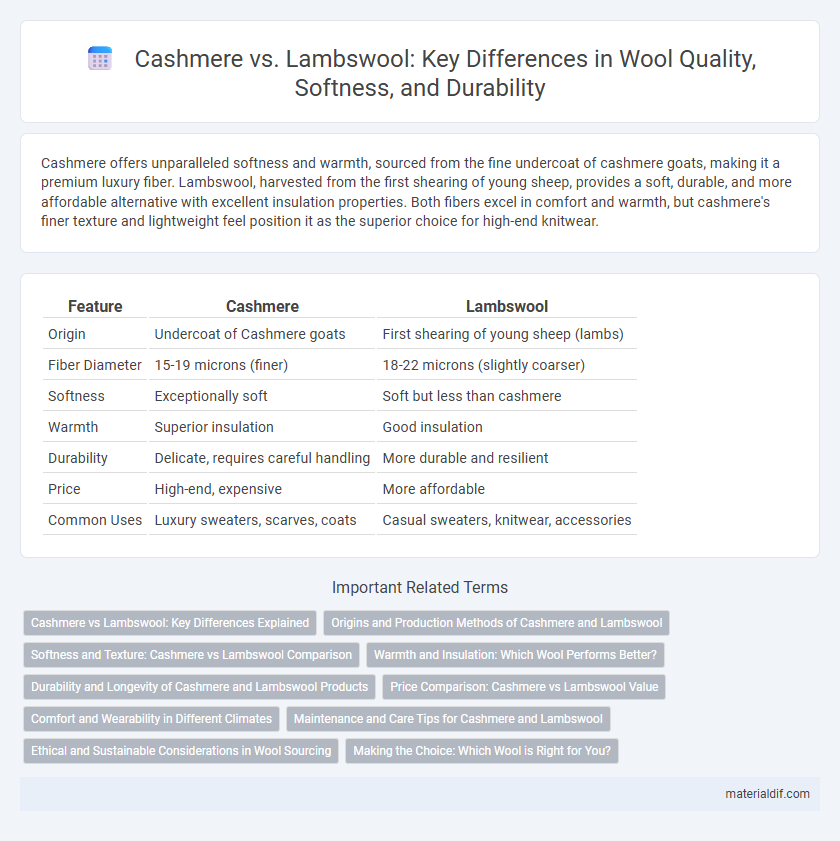Cashmere offers unparalleled softness and warmth, sourced from the fine undercoat of cashmere goats, making it a premium luxury fiber. Lambswool, harvested from the first shearing of young sheep, provides a soft, durable, and more affordable alternative with excellent insulation properties. Both fibers excel in comfort and warmth, but cashmere's finer texture and lightweight feel position it as the superior choice for high-end knitwear.
Table of Comparison
| Feature | Cashmere | Lambswool |
|---|---|---|
| Origin | Undercoat of Cashmere goats | First shearing of young sheep (lambs) |
| Fiber Diameter | 15-19 microns (finer) | 18-22 microns (slightly coarser) |
| Softness | Exceptionally soft | Soft but less than cashmere |
| Warmth | Superior insulation | Good insulation |
| Durability | Delicate, requires careful handling | More durable and resilient |
| Price | High-end, expensive | More affordable |
| Common Uses | Luxury sweaters, scarves, coats | Casual sweaters, knitwear, accessories |
Cashmere vs Lambswool: Key Differences Explained
Cashmere originates from the soft undercoat of Cashmere goats, offering exceptional softness and insulation compared to Lambswool, which comes from the first shearing of young sheep and is slightly coarser. Cashmere fibers are finer, measuring between 14-19 microns, while Lambswool fibers typically range from 18-25 microns, impacting softness and durability. Due to its rarity and delicate processing, Cashmere is more expensive and prized for luxury garments, whereas Lambswool provides warmth and resilience ideal for everyday wear.
Origins and Production Methods of Cashmere and Lambswool
Cashmere originates from the undercoat of Cashmere goats primarily found in Mongolia, China, and Iran, where fibers are hand-combed during the spring molting season to ensure softness and fineness. Lambswool, sourced from the first shearing of young sheep usually under seven months old in countries like the UK, Australia, and New Zealand, involves machine or hand shearing that captures the softest, finest wool with minimal coarse fibers. Production methods for Cashmere emphasize meticulous hand combing to maintain fiber quality, while Lambswool production relies on timely shearing to harvest tender fibers before the animal matures.
Softness and Texture: Cashmere vs Lambswool Comparison
Cashmere fibers are finer and smoother than lambswool, resulting in a luxuriously soft texture that feels gentle against the skin. Lambswool, harvested from young sheep, offers a thicker, slightly coarser texture with a springy feel that provides warmth and durability. The superior softness of cashmere makes it ideal for high-end garments, while lambswool balances softness with resilience for everyday wear.
Warmth and Insulation: Which Wool Performs Better?
Cashmere offers superior warmth and insulation due to its finer, softer fibers, which trap heat more effectively than lambswool. Lambswool, being thicker and coarser, provides durable insulation but may feel heavier and less breathable compared to cashmere. For optimal warmth with lightweight comfort, cashmere outperforms lambswool in thermal insulation properties.
Durability and Longevity of Cashmere and Lambswool Products
Cashmere fibers, derived from the undercoat of Cashmere goats, are finer and softer but less durable than the coarser, stronger fibers of lambswool, which comes from young sheep. While cashmere products provide luxurious softness and excellent insulation, lambswool garments offer superior resilience and longer wear life due to their robust fiber structure. Proper care extends the longevity of both materials, but lambswool consistently outperforms cashmere in durability under frequent use.
Price Comparison: Cashmere vs Lambswool Value
Cashmere is significantly more expensive than lambswool due to its rarity and the labor-intensive process of harvesting fibers from cashmere goats. Lambswool offers a more affordable alternative with good warmth and softness, making it popular for budget-conscious consumers. Despite higher upfront costs, cashmere's luxurious softness and durability often provide better long-term value for premium wool products.
Comfort and Wearability in Different Climates
Cashmere offers unmatched softness and warmth, making it ideal for colder climates where insulation and lightweight comfort are crucial. Lambswool provides durable warmth with a slightly coarser texture, performing well in milder or variable weather due to its breathable and moisture-wicking properties. Both fibers excel in comfort, but cashmere is preferred for luxurious softness, while lambswool delivers better wearability in transitional seasons.
Maintenance and Care Tips for Cashmere and Lambswool
Cashmere requires delicate care involving hand washing with cold water and mild detergent or dry cleaning to preserve its softness and prevent damage. Lambswool is more durable and can typically be hand washed or machine washed on a gentle cycle, though it should still be air-dried flat to maintain shape. Both fibers benefit from storage in breathable garment bags and regular de-pilling to extend longevity and retain their luxurious texture.
Ethical and Sustainable Considerations in Wool Sourcing
Cashmere production often faces criticism for environmental degradation and unethical animal treatment due to overgrazing by cashmere goats and associated habitat damage. Lambswool, sourced from the first shearing of young sheep, typically involves more sustainable farming practices with lower environmental impact and better animal welfare standards. Consumers prioritize ethically raised lambswool for its renewable nature, reduced carbon footprint, and adherence to humane animal treatment compared to many cashmere supply chains.
Making the Choice: Which Wool is Right for You?
Cashmere offers unparalleled softness and lightweight warmth, making it ideal for luxury garments that require delicate care. Lambswool provides robust durability and natural elasticity, perfect for daily wear and maintaining shape over time. Choosing between cashmere and lambswool depends on prioritizing either premium softness or long-lasting resilience for your wardrobe needs.
Cashmere vs Lambswool Infographic

 materialdif.com
materialdif.com